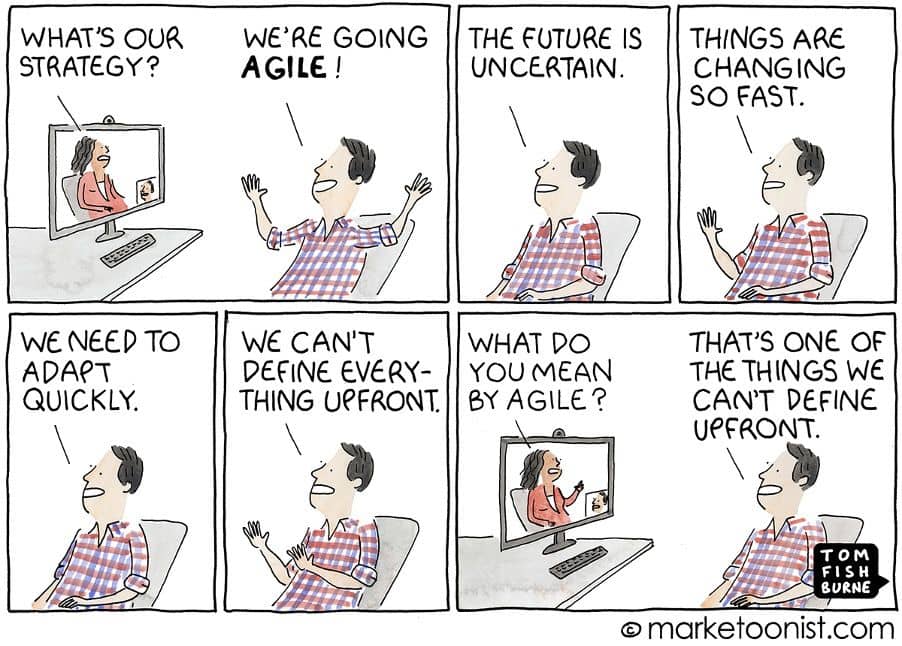Blog
Fashion marketing's new look – How enterprise fashion companies can thrive in 2022
February 25, 2022 | Chris Kervinen

Rapid digitalization during recent years has eroded the economies of scale within the fashion retail industry, paving the way for new fashion companies. There are an estimated 20,000 fashion brands across the globe, with new brands launching every week. At the same time up to 30 enterprise fashion companies have filed for bankruptcy during the past couple year, and Covid-19 is not alone to blame to this shift in power.
When in the past being big granted you wider access to wholesalers, lower production costs and option to leverage mass media in your marketing, today the same benefits can be acquired by the small as well. Third-party manufacturing, e-commerce and digital marketing have democratized fashion retail during recent years.

Enterprise fashion companies have to rework their marketing functions in the new era of fashion marketing.
Winners in this market are often companies that have invested and build an effective customer acquisition machine, and thereby can justify larger budgets and higher growth trend than their competitors. Enterprise fashion companies must rework their marketing function through the following three steps:
· Turn your marketing budgets into investments for growth
· Switch to shorter, more collaborative feedback loops
· Build an integrated marketing technology and data stack
Turn your marketing budgets into investments for growth
Enterprise fashion companies utilize a lot of brand marketing, which can affect what kind of KPIs are set to track the success of campaigns and marketing in general. As ongoing, long-term activity it is difficult to measure what business impact individual activities and campaigns drive, or the ROI for the investments.
This can steer the conversation towards costs instead of investments, which in turn inhibits marketing to grow with the business, as cost reductions and efficiencies are prioritized over growth and effectiveness.
Flipping the situation starts with building a better relationship with the finance department . The finance team is usually interested to understand how different functions are contributing in the overall business strategy, so inviting them into the marketing campaign cockpit is a great way to make them feel that the budget is in good hands. Browser-based dashboards such as Sellfote help to share the insights with as many people as necessary.

You can build a great relationship between finance and marketing by being upfront with what you’re trying to accomplish with your marketing plan.
What you don’t want to do is talk to your finance team only when you need money. Start by explaining what you want to achieve with your marketing plan and how it links back to wider business strategy. Build trust and alignment by being honest what can and what can’t be measured and try to get as much data as possible before and during the campaign to avoid appearing as a black box investment.
What marketing is trying to achieve
As in any other business area, marketing also needs to have a narrative behind the decisions. Explain what you’re trying to achieve and why. The why-part is especially important – it is often the leading factor in inspiring action – so spending time to really explain the context, the concept and the motivation behind this campaign helps the finance team to get on board your plan and you to get a buy-in.
Whatever the narrative, it is essential to link your plan to the wider business strategy as well. Including effectiveness metrics such as ROMI can help in assuring that you're tracking the business impact of the marketing activities, but also how different investments compare against each other (and if there's room for improvement).
What can and can’t be measured
After setting the scene, it should be clear what kind of direct and indirect KPIs will track whether something’s working or not. Try to also get as close to real time information from the campaigns as possible. The ability to adjust and improve things helps to avoid marketing being perceived as a black box investment – which is exactly what finance team dislikes.
It is also important to be honest about things that can’t be measured. Marketing includes many qualitative aspects that data cannot capture, and trying to force them under quantitative analysis can greatly hinder the trust between finance and marketing.
Switch to shorter, more collaborative feedback loops
Above everything else, enterprise fashion companies need agility to compete with smaller companies that are already leveraging shorter test & learn cycles.

Agility’s on every company’s wish list, yet only a few have invested into required tools and processes to reach truly streamlined loop between analytics and actions. Cartoon by Marketoonist .
This can be achieved by letting go of the traditional ROMI modelling projects that are implemented every 6 months. Instead, enterprise fashion companies should move to continuous modelling that puts more emphasis on the situational factors (such as seasonality that is super crucial for within fashion retail) and provides better testing & learning capabilities.
Data-driven initiatives by Burger King and Coca-Cola have shown that brand marketing can be measured and optimized, but that it requires omnichannel approach with rigorous number crunching.
Coca-Cola’s global CMO Manolo Arroyo said “It will enable us to create end-to-end experiences that are grounded in data-rich insights and optimised real-time, at scale, as we learn from consumers”.
Burger King is also doubling down on the data, and the US and Canada president Tom Curtis claimed the company has built “better testing protocols to ensure its advertising and marketing initiatives are well chosen and more impactful”.
Continuous process plays a key role in how marketing is perceived, inside and outside the function. For marketers it encourages to discover room for improvement, already while the campaign is still running. For other functions (e.g. the finance department) it helps by introducing transparency into the question of marketing effectiveness and lifting the image of marketing as a black box investment.
In addition to continuity, the operating model needs to become more collaborative & cross-functional than ever. Enterprise fashion companies can create silos over time as they grow, and breaking these silos by aligning the efforts of internal and external teams will help companies to build synergies between sales, marketing, media, merchandising and other commercial teams.
Cross-functional synergies start to emerge when different teams work towards the same objectives with comparable metrics. Having shared business targets is quite common today, but where most companies fall short is measuring impact of different activities the same way regardless of the team.

Having shared and comparable metrics helps different teams to pull together, as it makes progress more tangible and actionable.
Media and brand KPIs are an essential part of marketing metrics, but when working with non-marketing teams, it’s applicable to have metrics such as incremental sales, incremental margin, and Return on Marketing Investment (ROMI) that are tangible and relevant for other business units (as well as top management).
Build an integrated marketing technology and data stack
Fashion marketers are known for their daring, bold approach. But due to size of the marketing departments within enterprise fashion companies, bold actions alone aren’t enough. You need to utilize technology to ensure decisions and initiatives are backed up with hard numbers.
For bigger brands to match the newcomers’ agility within fashion retail sector, the objective should be to build a collaborative, continuous, and transparent marketing machine. It is extremely difficult to achieve any of these aspects with manual labor, let alone all of them, as there’s substantial amount of data, wide media mix in use, and potentially multiple overlapping campaigns.
Instead, new innovative tools automate most of the steps in building the insights to support the decisions, while also making the data and results available for all commercial units. The most important step is to build a solution that provides comparable metrics (such as ROMI) to introduce collaborative aspects into play.
Why expertise alone won’t cut it anymore
Back in the day expertise used to provide fashion retailers the competitive edge to thrive at the industry. But today, digitalization has offset some of the aspects that could be leveraged: data is challenging experience in decisions, internet is democratizing supply chains and new marketing channels provide potential alternative to traditional media.
What you knew yesterday could be outdated already today, especially when going against young companies that could have existed solely in the digital world. They can’t match the enterprise fashion companies on traditional arenas, but as the pace of digitalization is increasing exponentially (and with the pandemic having its own impact in this), the new status quo will favor players that can harness technology in their marketing operations, regardless of the size of the company.
Investing in integrated marketing technology and data stack is a relevant challenge for all B2C industries, but it’s exceptionally crucial for enterprise fashion retailers that are facing a steep decline in physical retail space. Combining this trend with the dynamic and unpredictable changes in consumer behavior causes creative destruction within fashion marketing that only the most adaptive businesses can survive.
Speedos and bikinis are back in fashion as it’s time to sink or swim.
Curious to learn more? Book a demo.
Related articles
Read more postsNo items found!